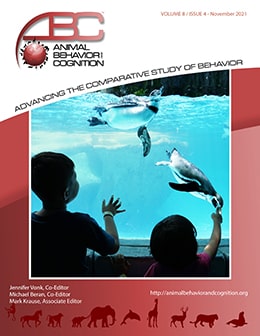Vol 8, Issue 4, November 2021
Effects of Visitor Presence and Crowd Size on Zoo-Housed Red Kangaroos (Macropus Rufus) During and After a COVID-19 Closure
Citation
Jones, M., Gartland, K. N., & Fuller, G. (2021). Effects of visitor presence and crowd size on zoo-housed red kangaroos (Macropus rufus) during and after a COVID-19 closure. Animal Behavior and Cognition, 8(4), 521-537. https://doi.org/10.26451/abc.08.04.06.2021
Abstract
Macropods, particularly kangaroos and wallabies, are common species included in walk-through habitats that put them in close proximity to zoo visitors. However, there has been little research into how visitor presence and density impact the welfare of these individuals. We monitored the behavior and space use of fifteen red kangaroos (Macropus rufus) for a total of ten weeks during and after a nearly three-month zoo closure due to the COVID-19 pandemic. Our findings revealed potential visitor effects, evidenced by more time spent in social proximity, greater inactivity, and more restricted space use after the zoo reopened. Although temperature and weather likely played a role in at least some of these behavioral changes, social proximity and space use changed with crowd size in a manner consistent with our zoo status (i.e., open or closed) results. Additionally, time spent feeding was significantly related to crowd size but not zoo status, such that the kangaroos spent more time feeding when there were no visitors in the habitat. These findings suggest that visitor effects explain these behavioral changes better than seasonal confounds. We also noted several individual differences in response to visitor presence and crowd size, highlighting the importance of evaluating behavioral responses to visitors on an individual basis.
Keywords
Visitor effects, Red kangaroo, Macropods, Walk-through habitat, Zoo, Welfare
